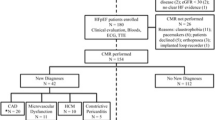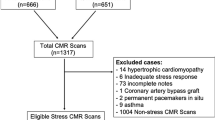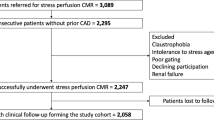Abstract
Negative stress echocardiography (NSE) is associated with low cardiovascular morbidity and overall mortality. We aimed to determine the clinical and echocardiographic predictors of overall and cardiovascular outcomes following NSE. Patients who underwent SE between 2013 and 2017 were reviewed. Patients with a history of solid organ transplant or being evaluated for transplant, history of end-stage renal or liver disease, and positive SE were excluded. NSE results were divided into negative diagnostic if patient reached target heart rate (THR) and had no wall motion abnormality (WMA) at rest or stress; negative non-diagnostic if patient had no WMA but did not reach THR or if image quality was non-diagnostic; and abnormal non-ischemic if patient had a resting WMA not worsened at stress along with a personal history of coronary artery disease (CAD). New CAD lesion at 1 year was defined as ≥ 50% stenosis on cardiac catheterization. Of 4119 patients with SE, 2575 were included. All-cause mortality rate was 1.1%/year and CAD rate was 3.1%/year. Predictors of all-cause mortality were age, male gender, history of smoking and being selected for dobutamine SE. Predictors of a new CAD lesion at 1 year were male gender, diabetes, personal history of CAD and abnormal non-ischemic SE. We identified clinical and echocardiographic characteristics in a subset of NSE patients who are at higher risk for subsequent adverse events. These characteristics should be accounted for during the clinical interpretation of SE, and patients found at increased risk for morbidity and mortality warrant continued follow-up.


Similar content being viewed by others
References
Marwick TH (2018) Stress echocardiography. Springer, Echocardiography, pp 491–519
Sicari R, Pasanisi E, Venneri L, Landi P, Cortigiani L, Picano E (2003) Stress echo results predict mortality: a large-scale multicenter prospective international study. J Am Coll Cardiol 41:589–595
Sawada SG, Ryan T, Conley MJ, Corya BC, Feigenbaum H, Armstrong WF (1990) Prognostic value of a normal exercise echocardiogram. Am Heart J 120:49–55
Steinberg EH, Madmon L, Patel CP, Sedlis SP, Kronzon I, Cohen JL (1997) Long-term prognostic significance of dobutamine echocardiography in patients with suspected coronary artery disease: results of a 5-year follow-up study. J Am Coll Cardiol 29:969–973
McCully RB, Roger VL, Mahoney DW, Karon BL, Oh JK, Miller FA et al (1998) Outcome after normal exercise echocardiography and predictors of subsequent cardiac events: follow-up of 1,325 patients. J Am Coll Cardiol 31:144–149
Senior R, Monaghan M, Becher H, Mayet J, Nihoyannopoulos P (2005) Stress echocardiography for the diagnosis and risk stratification of patients with suspected or known coronary artery disease: a critical appraisal. Supported by the British Society of Echocardiography. Heart 91:427–436
Metz LD, Beattie M, Hom R, Redberg RF, Grady D, Fleischmann KE (2007) The prognostic value of normal exercise myocardial perfusion imaging and exercise echocardiography: a meta-analysis. J Am Coll Cardiol 49:227–237
Batal O, Malhotra S, Harinstein M, Markowitz J, Hickey G, Agarwal S et al (2019) Performance of traditional pretest probability estimates in stable patients undergoing myocardial perfusion imaging. Circulation 12:e008473
Rachwan RJ, Mshelbwala FS, Dardari Z, Batal O (2019) False-positive stress echocardiograms: predictors and prognostic relevance. Int J Cardiol 296:157–163
Pellikka PA, Nagueh SF, Elhendy AA, Kuehl CA, Sawada SG (2007) American Society of Echocardiography recommendations for performance, interpretation, and application of stress echocardiography. J Am Soc Echocardiogr 20:1021–1041
Ismail G, Lo E, Sada M, Conant RD, Shapiro SM, Ginzton LE (1995) Long-term prognosis of patients with a normal exercise echocardiogram and clinical suspicion of myocardial ischemia. Am J Cardiol 14:934–936
Davar J, Roberts E, Coghlan J, Evans T, Lipkin D (2001) Prognostic value of stress echocardiography in women with high (⩾ 80%) probability of coronary artery disease. Postgrad Med J 77:573–577
Walker J, Galuska M, Vega D (2010) Coronary disease in emergency department chest pain patients with recent negative stress testing. West J Emerg Med 11:384
Diamond GA, Forrester JS (1979) Analysis of probability as an aid in the clinical diagnosis of coronary-artery disease. N Engl J Med 300:1350–1358
Rosella LC, Calzavara A, Frank JW, Fitzpatrick T, Donnelly PD, Henry D (2016) Narrowing mortality gap between men and women over two decades: a registry-based study in Ontario, Canada. BMJ Open 6:e012564
Crimmins EM, Shim H, Zhang YS, Kim JK (2019) Differences between men and women in mortality and the health dimensions of the morbidity process. Clin Chem 65:135–145
Oksuzyan A, Juel K, Vaupel JW, Christensen K (2008) Men: good health and high mortality. Sex differences in health and aging. Aging Clin Exp Res 20:91–102
Doyle JT, Dawber TR, Kannel WB, Heslin AS, Kahn HA (1962) Cigarette smoking and coronary heart disease: combined experience of the Albany and Framingham studies. N Engl J Med 266:796–801
Gellert C, Schöttker B, Brenner H (2012) Smoking and all-cause mortality in older people: systematic review and meta-analysis. Arch Intern Med 172:837–844
Kokkinos P, Faselis C, Myers J, Sui X, Zhang J, Blair SN (2014) Age-specific exercise capacity threshold for mortality risk assessment in male veterans. Circulation 130:653–658
Rozanski A, Gransar H, Hayes SW, Friedman JD, Hachamovitch R, Berman DS (2010) Comparison of long-term mortality risk following normal exercise vs adenosine myocardial perfusion SPECT. J Nucl Cardiol 17:999–1008
Kamalesh M, Matorin R, Sawada S (2002) Prognostic value of a negative stress echocardiographic study in diabetic patients. Am Heart J 143:163–168
Smith SC, Allen J, Blair SN, Bonow RO, Brass LM, Fonarow GC et al (2006) AHA/ACC guidelines for secondary prevention for patients with coronary and other atherosclerotic vascular disease: 2006 update: endorsed by the National Heart, Lung, and Blood Institute. J Am Coll Cardiol 47:2130–2139
Araujo ACPd, Santos BF, Calasans FR, Pinto IM, Oliveira DP, Melo LD et al (2014) Physical stress echocardiography: prediction of mortality and cardiac events in patients with exercise test showing ischemia. Arq Bras Cardiol 103:418–425
Schlett CL, Banerji D, Siegel E, Bamberg F, Lehman SJ, Ferencik M et al (2011) Prognostic value of CT angiography for major adverse cardiac events in patients with acute chest pain from the emergency department: 2-year outcomes of the ROMICAT trial. JACC Cardiovasc Imaging 4:481–491
Frans JT, Russo DJ, Russo D, Clements JP (1985) Prognostic significance of normal quantitative planar thallium-201 stress scintigraphy in patients with chest pain. J Am Coll Cardiol 6:27–30
Pamelia FX, Gibson RS, Watson DD, Craddock GB, Sirowatka J, Beller GA (1985) Prognosis with chest pain and normal thallium-201 exercise scintigrams. Am J Cardiol 55:920–926
Steinberg EH, Koss JH, Lee M, Grunwald AM, Bodenheimer MM (1993) Prognostic significance from 10-year follow-up of a qualitatively normal planar exercise thallium test in suspected coronary artery disease. Am J Cardiol 71:1270–1273
Brown K (1991) Prognostic value of thallium-201 myocardial perfusion imaging. A diagnostic tool comes of age. Circulation 83:363–381
Ottenhof MJ, Wai MCTJ, Boiten HJ, Korbee RS, Valkema R, van Domburg RT et al (2013) 12-Year outcome after normal myocardial perfusion SPECT in patients with known coronary artery disease. J Nucl Cardiol 20:748–754
Deseive S, Shaw LJ, Min JK, Achenbach S, Andreini D, Al-Mallah MH et al (2017) Improved 5-year prediction of all-cause mortality by coronary CT angiography applying the CONFIRM score. Eur Heart J 18:286–293
o Hartaigh B, Valenti V, Cho I, Schulman-Marcus J, Gransar H, Knapper J et al (2016) 15-year prognostic utility of coronary artery calcium scoring for all-cause mortality in the elderly. Atherosclerosis. 246:361–366
Min JK, Dunning A, Lin FY, Achenbach S, Al-Mallah M, Budoff MJ et al (2011) Age-and sex-related differences in all-cause mortality risk based on coronary computed tomography angiography findings: results from the International Multicenter CONFIRM (Coronary CT Angiography Evaluation for Clinical Outcomes: An International Multicenter Registry) of 23,854 patients without known coronary artery disease. J Am Coll Cardiol 58:849–860
Hecht HS (2015) Coronary artery calcium scanning: past, present, and future. JACC Cardiovasc Imaging 8:579–596
Kemp HG, Kronmal RA, Vlietstra RE, Frye RL (1986) Seven year survival of patients with normal or near normal coronary arteriograms: a CASS registry study. J Am Coll Cardiol 7:479–483
Hoffmann R, Lethen H, Marwick T, Arnese M, Fioretti P, Pingitore A et al (1996) Analysis of interinstitutional observer agreement in interpretation of dobutamine stress echocardiograms. J Am Coll Cardiol 27:330–336
Funding
None.
Author information
Authors and Affiliations
Corresponding author
Ethics declarations
Conflict of interest
None declared. All authors take responsibility for all aspects of the reliability and freedom from bias of the data presented and their discussed interpretation.
Additional information
Publisher's Note
Springer Nature remains neutral with regard to jurisdictional claims in published maps and institutional affiliations.
Rights and permissions
About this article
Cite this article
Rachwan, R.J., Mshelbwala, F.S., Bou Chaaya, R.G. et al. Long-term prognosis and predictors of outcomes after negative stress echocardiography. Int J Cardiovasc Imaging 36, 1953–1962 (2020). https://doi.org/10.1007/s10554-020-01913-6
Received:
Accepted:
Published:
Issue Date:
DOI: https://doi.org/10.1007/s10554-020-01913-6




